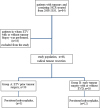Endoscopic third ventriculostomy before surgery of third ventricle and posterior fossa tumours decreases the risk of secondary hydrocephalus and early postoperative complications
- PMID: 34291350
- PMCID: PMC8827142
- DOI: 10.1007/s10143-021-01570-w
Endoscopic third ventriculostomy before surgery of third ventricle and posterior fossa tumours decreases the risk of secondary hydrocephalus and early postoperative complications
Abstract
Endoscopic third ventriculostomy (ETV) is an effective treatment for obstructive hydrocephalus (HCP) at the level of third or fourth ventricle. To date, there is no consensus regarding its role as intervention preceding the operation of tumour removal. The aim of this prospective open-label controlled study is to assess if ETV prevents secondary HCP after tumour removal and if ETV influences the early results of tumour surgery. The study was performed on 68 patients operated for tumours of the third ventricle and posterior fossa. In 30 patients, ETV was performed several days before tumour removal, while in 38 patients, the tumour was removed during a one-stage procedure without ETV. Patients who did not receive ETV before the tumour removal procedure had a higher probability of developing postoperative HCP (n = 12, p = 0.03). They also demonstrated a substantially higher rate of early postoperative complications (n = 20, p = 0.002) and a lower Karnofsky score (p = 0.004) than patients in whom ETV was performed before tumour removal. The performance of external ventricular drainage in the non-ETV group did not prevent secondary HCP (p = 0.68). Postoperative cerebellar swelling (p = 0.01), haematoma (p = 0.04), cerebrospinal fluid leak (p = 0.04) and neuroinfection (p = 0.04) were the main risk factors of persistent HCP. Performance of ETV before tumour removal is not only beneficial for control of acute HCP but also prevents the occurrence of secondary postoperative HCP and may also minimize early postoperative complications.
Keywords: Endoscopic third ventriculostomy; Secondary postoperative hydrocephalus; Tumour removal.
© 2021. The Author(s).
Conflict of interest statement
The authors declare no competing interests.
Figures




Similar articles
-
Endoscopic third ventriculostomy in the treatment of hydrocephalus in posterior fossa tumors in children.Childs Nerv Syst. 2004 Nov;20(11-12):828-33. doi: 10.1007/s00381-004-0938-y. Epub 2004 Jun 25. Childs Nerv Syst. 2004. PMID: 15221247 Clinical Trial.
-
Endoscopic third ventriculostomy: the best option in the treatment of persistent hydrocephalus after posterior cranial fossa tumour removal?Childs Nerv Syst. 2008 Dec;24(12):1405-12. doi: 10.1007/s00381-008-0699-0. Epub 2008 Sep 24. Childs Nerv Syst. 2008. PMID: 18813936
-
Antibiotic impregnated external ventricular drainage and third ventriculostomy in the management of hydrocephalus associated with posterior cranial fossa tumours.Acta Neurochir (Wien). 2008 Oct;150(10):1049-55; discussion 1055-6. doi: 10.1007/s00701-008-0022-6. Epub 2008 Sep 6. Acta Neurochir (Wien). 2008. PMID: 18777004
-
Endoscopic third ventriculostomy and posterior fossa tumors.World Neurosurg. 2013 Feb;79(2 Suppl):S18.e15-9. doi: 10.1016/j.wneu.2012.02.018. Epub 2012 Feb 10. World Neurosurg. 2013. PMID: 22381845 Review.
-
Role of Secondary Endoscopic Third Ventriculostomy in Children: Review of an Institutional Experience.Pediatr Neurosurg. 2019;54(3):188-195. doi: 10.1159/000500641. Epub 2019 Jun 3. Pediatr Neurosurg. 2019. PMID: 31158842 Review.
Cited by
-
Complications and risk factors of endoscopic third ventriculostomy: A 10-year single-centre study and systematic literature review.Brain Spine. 2025 Jun 1;5:104291. doi: 10.1016/j.bas.2025.104291. eCollection 2025. Brain Spine. 2025. PMID: 40528870 Free PMC article.
References
-
- Di Rocco F, Jucá CE, Zerah M, Sainte-Rose C (2013) Endoscopic third ventriculostomy and posterior fossa tumors. World Neurosurg 79(2 Suppl): S18.e15–9 - PubMed
MeSH terms
LinkOut - more resources
Full Text Sources
Medical
Miscellaneous

